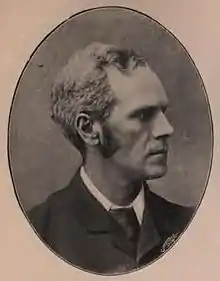William Bousfield | |
|---|---|
 | |
| Born | 12 January 1854 |
| Died | 16 July 1943 (aged 89) |
| Nationality | British |
| Education | Bedford Modern School |
| Alma mater | Caius College, Cambridge |
William Robert Bousfield FRS KC (12 January 1854 – 16 July 1943) was a British lawyer, Conservative politician and scientist.[1][2]
Biography
Bousfield was the son of Edward Tenney Bousfield, an engineer, and his wife Charlotte Eliza Collins, who was a noted diarist. He was born at Newark-on-Trent, from which his family moved to Sticklepath in 1856 and then to Bedford, where they arrived in September 1858.[3]
He attended Bedford Modern School before serving an apprenticeship as an engineer. In 1872 he was admitted to Caius College, Cambridge, winning a scholarship there in 1873.[4] Following graduation as 16th Wrangler in 1876 and a brief period as a lecturer at the University of Bristol, where he delivered the new institution's first ever lecture (on Mathematics at 9 a.m. 10 October 1876), he decided to study law.[5][6] In 1880 he was called to the bar at the Inner Temple. His knowledge of engineering led to him becoming a renowned expert on patent law.[7] He became a Queen's Counsel in 1891 (which office became King's Counsel on the accession of a King in 1901).[7] He was elected a bencher of the Inner Temple in 1897, and treasurer in 1920.[7]
Politically, Bousfield was a Conservative, and stood unsuccessfully twice for election as Member of Parliament for Mid Lanarkshire in the 1880s. He entered the Commons at a By-election at Hackney North in May 1892. He held the seat at the 1895 and 1900 elections, before being unseated by Thomas Hart-Davies, when the Liberals swept to power at the 1906 general election. He did not stand for election again.[7]
Bousfield was an enthusiastic amateur scientist, particularly interested in physical chemistry and electrolysis. He worked in collaboration with T M Lowry, and their work was published in the Proceedings of the Royal Society,[8][9][10][11][12][13][14][15] of which Bousfield was made a fellow in 1916.[1] When his health began to fail in the 1920s, he was no longer able to carry out laboratory experiments, and turned his attention to psychology. He wrote three books on the subject: A Neglected Complex (1924), The Mind and its Mechanism (1927) and The Basis of Memory (1928).[1][7]
Personal life
In 1879 he married Florence Kelly of Shanklin, Isle of Wight.[1][7] Their sons included Paul Bousfield, a specialist in nervous diseases;[7] and John Keith Bousfield (1893–1945), an army officer, businessman, and member of the Legislative Council of Hong Kong.
W. R. Bousfield died in Ottery St Mary in July 1943, aged 89.[1][7]
References
- 1 2 3 4 5 Dampier, W. C. D. (1944). "William Robert Bousfield. 1854-1943". Obituary Notices of Fellows of the Royal Society. 4 (13): 570–576. doi:10.1098/rsbm.1944.0008. JSTOR 768848. S2CID 177199075.
- ↑ "Bousfield, William Robert, (12 Jan. 1854–16 July 1943)". WHO'S WHO & WHO WAS WHO. 2007. doi:10.1093/ww/9780199540884.013.U222855. ISBN 978-0-19-954089-1.
- ↑ Bousfield, Charlotte Eliza (2007). Smart, Richard (ed.). The Bousfield Diaries: A Middle-Class Family in Late Victorian Bedford. Bedfordshire Historical Record Society. pp. xiii–xiv. ISBN 978-0-85155-075-6.
- ↑ "Bousfield, William Robert (BSFT872WR)". A Cambridge Alumni Database. University of Cambridge.
- ↑ H.E. Vipan,Register of the Old Boys of the Bedford Modern School (Bedford, no date), p. 15
- ↑ J.W. Shelbourne, 'University College, Bristol', (Historical Association Papers, University of Bristol, 1977), p. 1
- 1 2 3 4 5 6 7 8 "Obituary: Mr W R Bousfield, K.C., F.R.S.". The Times. 19 July 1943. p. 6.
- ↑ Bousfield, W. R.; Bousfield, W. E. (1911). "The Specific Heat of Water". Proceedings of the Royal Society A: Mathematical, Physical and Engineering Sciences. 85 (578): 302. Bibcode:1911RSPSA..85..302B. doi:10.1098/rspa.1911.0043.
- ↑ Bousfield, W. R.; Bousfield, C. E. (1923). "Vapour Pressure and Density of Sodium Chloride Solutions". Proceedings of the Royal Society A: Mathematical, Physical and Engineering Sciences. 103 (722): 429. Bibcode:1923RSPSA.103..429B. doi:10.1098/rspa.1923.0068.
- ↑ Bousfield, W. R. (1914). "Note on Osmotic Pressure". Proceedings of the Royal Society A: Mathematical, Physical and Engineering Sciences. 90 (615): 41–45. Bibcode:1914RSPSA..90...41B. doi:10.1098/rspa.1914.0033.
- ↑ Bousfield, W. R. (1917). "Note on the Specific Heat of Water". Proceedings of the Royal Society A: Mathematical, Physical and Engineering Sciences. 93 (655): 587–591. Bibcode:1917RSPSA..93..587B. doi:10.1098/rspa.1917.0042.
- ↑ Bousfield, W. R. (1914). "The Osmotic Data in Relation to Progressive Hydration". Proceedings of the Royal Society A: Mathematical, Physical and Engineering Sciences. 90 (621): 544–548. Bibcode:1914RSPSA..90..544B. doi:10.1098/rspa.1914.0082.
- ↑ Bousfield, W. R. (1906). "Ionic Size in Relation to the Physical Properties of Aqueous Solutions". Proceedings of the Royal Society A: Mathematical, Physical and Engineering Sciences. 77 (518): 377–384. Bibcode:1906RSPSA..77..377B. doi:10.1098/rspa.1906.0033.
- ↑ Glazebrook, R. T.; Bousfield, W. R.; Smith, F. E. (1911). "The Heating Effect of the Currents in Precise Measurements of Electrical Resistance". Proceedings of the Royal Society A: Mathematical, Physical and Engineering Sciences. 85 (581): 541. Bibcode:1911RSPSA..85..541G. doi:10.1098/rspa.1911.0068.
- ↑ Bousfield, W. R. (1913). "Ionic Size in Relation to Molecular Physics, Together with a New Law Relating to the Heats of Formation of Solid, Liquid, and Ionic Molecules". Proceedings of the Royal Society A: Mathematical, Physical and Engineering Sciences. 88 (602): 147–169. Bibcode:1913RSPSA..88..147B. doi:10.1098/rspa.1913.0015.